Ysartnews Issue 4 - March 1988
Edited by Mary Houston-Lambert 2002
Editorial
New discoveries - Terminology
Identifying Ysart Glass (Part Two) External Article
Ysart Glass bibliography External Article
British Paperweight Makers - Chart
Paul Ysart & His Paperweights. by A. J. CIarke External Article.
John Moncrieff, Senior, by M. T. Vaughan
Cambridge Paperweight Circle - Scottish Glass Society
Exhibitions - Information wanted - The book, YSART GLASS
Photographs
Editorial
The last eighteen months have been successful in achieving the clubīs aims of expanding awareness of the Ysart Glass. Our membership has continued to grow, as have general enquiries about the glass.
The most significant change over the past year has been the remarkable rise in the cost of the glass. Pieces have been changing hands in auction, mainly in Scotland, for over £200 on a regular basis. Sotheby’s in Chester are also beginning to correctly describe Monart in the decorative art sales and the only shadow on the horizon is the increasing amounts of Strathearn appearing with ground down pontil seals. Several instances of this have been reported to me in recent Scottish auctions and in antique fairs around the country. With the help of several collectors, we now have a good knowledge of who is responsible but are unable to take any action due to the lack of documentary evidence.
The sooner that catalogues are available for all, the better, but there are some common shapes to continue the confusion. Another deplorable activity is the splitting of labels between different pieces. I can only suggest that a part label be ignored when choosing a piece. The Perth copies continue to appear but are still easily recognised (see Ysartnews Issue 3). Many dealers who are now stocking occasional pieces of Monart and ‘Monart-like’ glass, have very little knowledge and usually welcome any information that a collector can give them. So if you do see a piece wrongly attributed, point it out and explain the reasons. Most dealers will correctly re-label a piece once they are aware. On the other hand there are those who will not and can even be quite rude if you comment. Fortunately these do seem to be very few.
Paul Ysart paperweights continue to rise in value in the UK but are staying steady, and cheaper, in the USA. A few small collections of his later weights have appeared on the market recently and several active collectors are still doing well discovering his unsigned weights.
Ian Turnerīs article on post-war production of Monart did not appear in the October 1997 issue of ‘The Antique Collector’, as mentioned in the last newsletter, but in “Antique Collecting”.
Condition is a major problem when collecting a glass that was made in such small quantities. It is significant that many of the early and very unusual pieces owned by club members have damage that would make a piece of Lalique uncollectable. Damage does detract from the value but when the piece is unique it can still have a value higher than many perfect Monart pieces of a more common type. Short stress cracks are so common in Monart that they are not a deterrent in any piece of Monart. Damaged Vasart, however, is not worth considering except for the really unusual.
Frank Andrews, March 1988.
New Discoveries
An important flower weight, containing a ‘PY’ cane AND a MONART label has recently come to light. The label bears the code ‘P/W No.15’ and this is the first documentary reference to the use of the ‘PY’ cane in the Monart period.
A signed Vasart bowl that is coloured in the Monart style of black & dark green with gold aventurine using the same enamels as found in the Monart examples has also been located. This is a very important discovery as it confirms one piece of hearsay evidence and adds a new piece of information to the history of Vasart glass. It has been said in the past that the Ysart family had taken some gold aventurine from Moncrieff when they left but that the limited amount they had was the reason that it was only used very sparingly in Vasart glass. This piece is made in the manner of Vasart, base Type 1 as illustrated in YsartNews 3, and the aventurine has been used sparingly.
This on its own does not confirm that they did not obtain their own supplies. But it is known that the enamels used at Moncrieff’s were unobtainable after the war so that the only possible source for the Ysart’s of the green enamels has to have been from Moncrieff’s. The assumption that can be made from the combination of hearsay and the evidence presented by this bowl is that they did in fact take a supply of colour and aventurine from Moncrieff´s when they left.
Terminological Inexactitudes
All specialist fields have their own vocabulary and glass is no exception. The newsletter avoids these where possible to save space on explanations and to make the information available to as wide an audience as possible. If collectors want to understand the processes and the vocabulary then there are plenty of books that provide the information. An understanding of the processes is an invaluable aid in appreciating glass, so a study of the technical side is recommended. We will gladly print any articles detailing techniques used within the range of our membership’s interests. Unfortunately, in the past, some terms have been used incorrectly in this newsletter. In particular the term ‘latticino’ has been used frequently to refer to the canes that are of clear glass containing a spiral or spirals in a colour. The term latticino derives from milk glass and only applies to white spirals. When other colours are included the correct term is ‘filigree’ and as most Ysart canes of this type do include a colour that is the term that should have been used. A good source of information of this kind is Harold Newman, An Illustrated Dictionary of Glass, pub. Thames and Hudson. This also details the many different types of paperweights with illustrations. A good introduction to most of the techniques used in glassmaking is found in ‘The History of Glass’ by D. Klein & W. Lloyd, Orbis 1984. But this is more a history then a technical guide.
Identifying Ysart Glass - Part 2
Identifying Ysart Glass (Part Two) External Article.
Bibliography
Bibliography of Ysart Glass External Article.
Chart
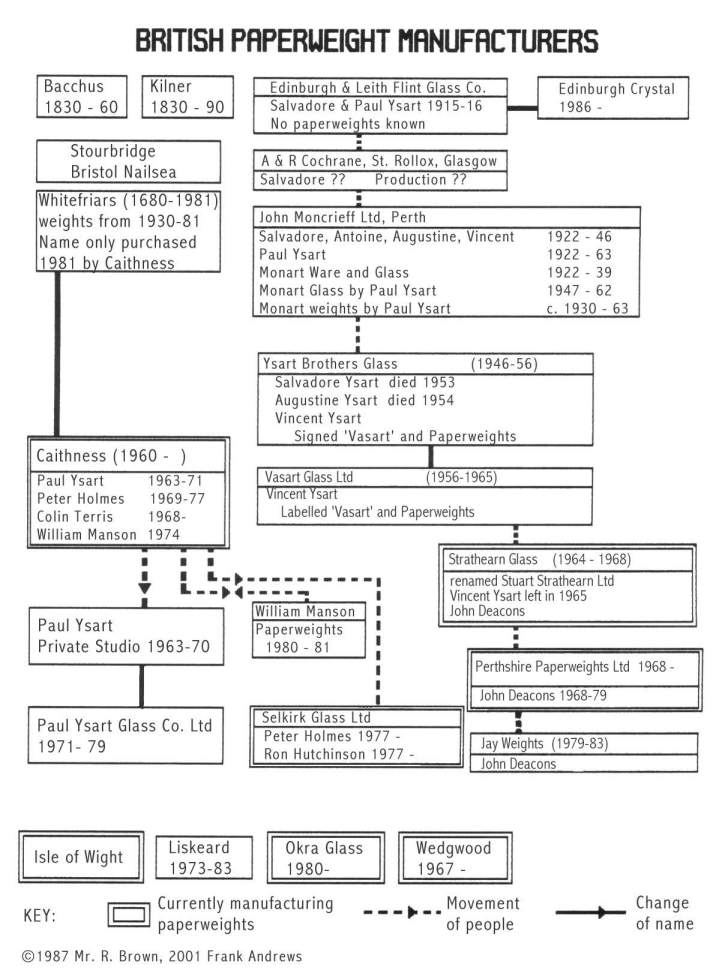
Paul Ysart & His Paperweights. by A. J. CIarke
This is now an external article, click on heading above.
Mr John Moncrieff (Ink Manufacturer) 1834-1899
John Moncrieff (Senior), ink manufacturer (not to be confused with his son John Moncrieff [1876 - 29th April 1950] of Monart fame) was born in Cherrybank, Perth. He attended the local village school until he was 13 years of age, when he was sent to work. On leaving the day school, he entered into the service of Mr. John Todd (1), ink manufacturer, and he did not neglect any opportunity to educate himself and attended evening classes. Promotion seems to have followed rapidly for on reaching the age of twenty-one he was appointed manager of Todd’s Glass Works - a position he filled with credit until the death of his employer John Todd. Thereafter Mr Moncrieff opened a similar works of his own (2) in South Street, Perth. Subsequently he moved business premises to St. Catherine’s Road, Perth (c.1881-82). He died at his residence Elmside, Balhousie, in Perth on Saturday, 30th September, 1899.
His obituarist (3) said of him:
“One gratifying thing about the career of Mr Moncrieff was that promotion and success seemed to have followed rapidly upon his strenuous and hearty efforts. From first to last the individuality of the man seems to have stamped itself upon every branch of his industry. When manager for Mr. Todd he built in the furnaces with his own hands a job so important that it could not be left to anybody with less skill than he himself possessed. His persistent experiments on the nature of glass and unwavering attention to business produced some time ago the famous gauge glasses. His life, however, had not been a selfish one, and during his busy career he had always found time to devote his services to Association and Societies which were for the benefit and welfare of the city. As an employer, he was respected by his employees, and he was honoured by his fellow-citizens. In all questions regarding the welfare of the city at large he took a keen interest, and when he thought it necessary he was one who was never afraid to express his opinion. In politics he was a staunch Liberal, and for many years occupied the position of Vice-President of the Perth Liberal Club and of the Perth Liberal Association. His figure will be much missed from Liberal circles in Perth. For five years he served the town council, and for twelve years he was a member of the School Board. In both of these capacities he was a much valued public servant. He was a staunch supporter of the Evangelical Union Church, now the E.U. and C.U. congregation of the city. In that body he occupied the position of Manager and President, and it was to a large extent through his generosity that the congregation are now the occupiers of one of the most beautiful buildings in Perth. He was President of the Perth Gospel Temperance Society, and always proved a strong and unswerving advocate for the cause of temperance. Among the other positions he held were those of ex-President of the Perth Bowling Club, and a Director of the Perth Bible Society. He was a member of the Tay Fishing Syndicate, which is the lessee of nearly all fishings on the Tay. Deceased is survived by a wife and grown-up family.”
Footnotes
- John Todd & Sons.
- North British Glassworks. Founded 1865.
- Perthshire Advertiser 2nd October 1899 p3. Perthshire Courier, 3rd October, 1899.
© 1978, Michael Thomas Vaughan
The author of this piece, a club member and a member of The Scottish Glass Society, has produced two other essays on Scottish glass and offers copies for sale: [2002. Check availability with author before sending money.]
“Monart & Vasart, Scottish Art Glass, The French Connection.” (Approximately 3,300 words.) £4.00 per copy including postage.
Covers the same ground as Ian Turner’s article in “British Glass Between The Wars”, but of interest to other members who have not seen a copy of that book.
Preliminary study, “The City Glass Works and Pottery, Glasgow”. Makers of ‘Clutha’ glass including those designed by Christopher Dresser. £5.00 per copy including postage.
Well produced article on this factory.
Order from the author at: 13 The Croft, Larkhall, Lanarkshire, Scotland. ML91AX.
Cambridge Paperweight Circle
The Circle was formed in 1981, by a nucleus of local enthusiasts, to promote the wider appreciation and collection of this art-form. The group holds regular meetings, normally with a guest speaker, and arranges visits to places of interest to paperweight collectors. The meetings are of an informal nature and offer ample opportunity for discussion with fellow collectors. Help is freely available to the novice on all aspects of the hobby.
Informative newsletters are distributed to members, giving up to date summaries of the commercial paperweight scene together with interesting articles on a range of relevant topics.
The only qualification for membership is an interest in the paperweight art. No specific level of knowledge or scale of personal collection is relevant.
If you would like to join, you will be made very welcome.
Apply to: The Secretary, CPC, See links page for current contact details
The Scottish Glass Society
See links page for current contact details
AIMS:
The Society was formed in 1979 as a result of agreement between Scottish glassworkers in all areas of the craft that a forum for the exchange of ideas and information would be useful. The aims of the Society are to promote the development of art and craftspersonship in the making of glass, stained glass, engraving of glass, and any other techniques or forms of decoration. To foster links with glass manufacturers or workshops, engraving studios or other bodies, also persons or Institutes otherwise interested in the craft of glass. To promote and advance public education in and stimulate a knowledge of the craft and its history by means of exhibitions, lectures, meetings, demonstrations, discussions, publications and other methods. To establish an index of craftspeople, and a newsletter as a positive link between members, particularly for those working in more remote areas of the country. To establish links with interested bodies throughout Scotland and the establishment of reciprocal exhibitions internationally.
ACTIVITIES:
An annual general meeting is held in October/November, and other meetings and visits are arranged throughout the year to, for example, the Edinburgh College of Art Glass Department, the Royal Scottish Museum Glass collection, the Museum & Art Gallery, Kelvingrove, Glasgow and to various glass factories and studies. There are also lectures from distinguished arts and crafts persons.
NEWSLETTER:
A newsletter is published at frequent intervals.
EXHIBITIONS:
Exhibitions are organised, in particular an annual exhibition in the Caithness Glass showrooms in Perth during the period in May of the Perth Music and Arts Festival.
MEMBERSHIP NUMBERS :
Over 400 individual members, 7 corporate members.
Exhibitions
The ‘British Glass Between the Wars’ exhibition did not move to a second venue, as reported in our previous issue.
The exhibition of Whitefriars continues at the London Museum until the end of 1988.
Information Wanted
The following adverts appeared in ‘The Antique Dealer and Collectors Guide’: August and November 1954.
Reproduction Glass Paperweights. Beautifully coloured and designed, supplied to the trade. American buyers please note. Letters only. T B Farrell, 24 York St’ London W1.
March 1955. Reproduction Glass Paperweights. Beautifully coloured and designed, in millefiori patterns, butterfly motifs, ink bottles with paperweight bases, etc. As supplied to the antique and allied trade. Price list gladly sent on request to: T B Farrell, 24 York St, London W1.
If anyone can provide any further information about the weights sold by T B Farrell, please let us know.
The Book
As reported in the last newsletter, a book on the Ysart Glass is now in preparation and should be available by the late Autumn. It will contain definitive articles on Monart, Vasart and Paul Ysart. Colour photographs will show the main colour types and finishes used in Monart and Vasart, plus weights and canes of Monart, Vasart and Paul Ysart. All the known Monart catalogue pages will be included along with colour catalogue pages from Liberty & Co. Club members will be given the opportunity to purchase this book at a special price. Fuller details will be given as soon as possible.
Photographs
[2002. These were originally prepared in black and white. At the moment I cannot locate all the colour originals so some are reproduced in black and white here.
Front Cover
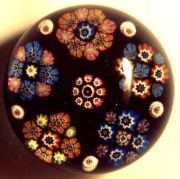
Paul Ysart, with PY cane, 2¾" diameter. Black ground. Millefiori clusters in various colours including: magenta, blue, deep blue, lilac, yellow, green, white. c1960/70’s.
THIS IS ONE OF THE 1988 FAKES
Page 25 top
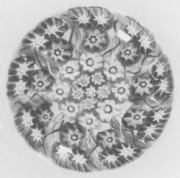
Vasart, 2½" diameter. Pastel yellow ground. Outer circle red & white canes, second circle green white & blue canes, third circle pale lilac & white canes, inner group green blue and white canes, filigree spokes clear with two spirals, one spiral red & yellow, the other green & white.
Back cover Top
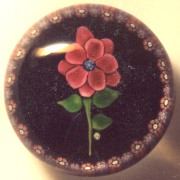
Paul Ysart, with PY cane, 3" diameter. Deep bright blue ground. Flower with yellow petals, green & red canes at centre. Green leaves and stem. Border purple & white canes with white filigree spokes.
THIS IS ONE OF THE 1988 FAKES
Inside Front Cover
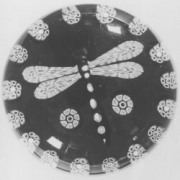
Paul Ysart, unsigned, 3" diameter. Deep blue ground. Dragonfly: Body, red aventurine with yellow & white canes; Wings pale green & pink canes. Alternating border of green, red & white cane and pink & white cane. Two blue, white and red canes either side of body. Post war.
Page 25 bottom
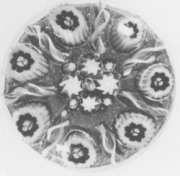
Vasart, 3" diameter. Madder red ground. Outer circle orange & black & white cane. Inner group blue & white canes. Filigree spokes an inner spiral of red and grey double twist and outer twin spiral of white.
Back cover Bottom
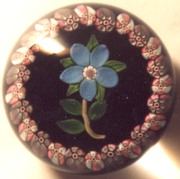
Paul Ysart, unsigned, 3" diameter. Deep Blue ground. Flower with yellow petals, white & red canes at centre. Green leaves and stem. Border lilac & white & pink canes.